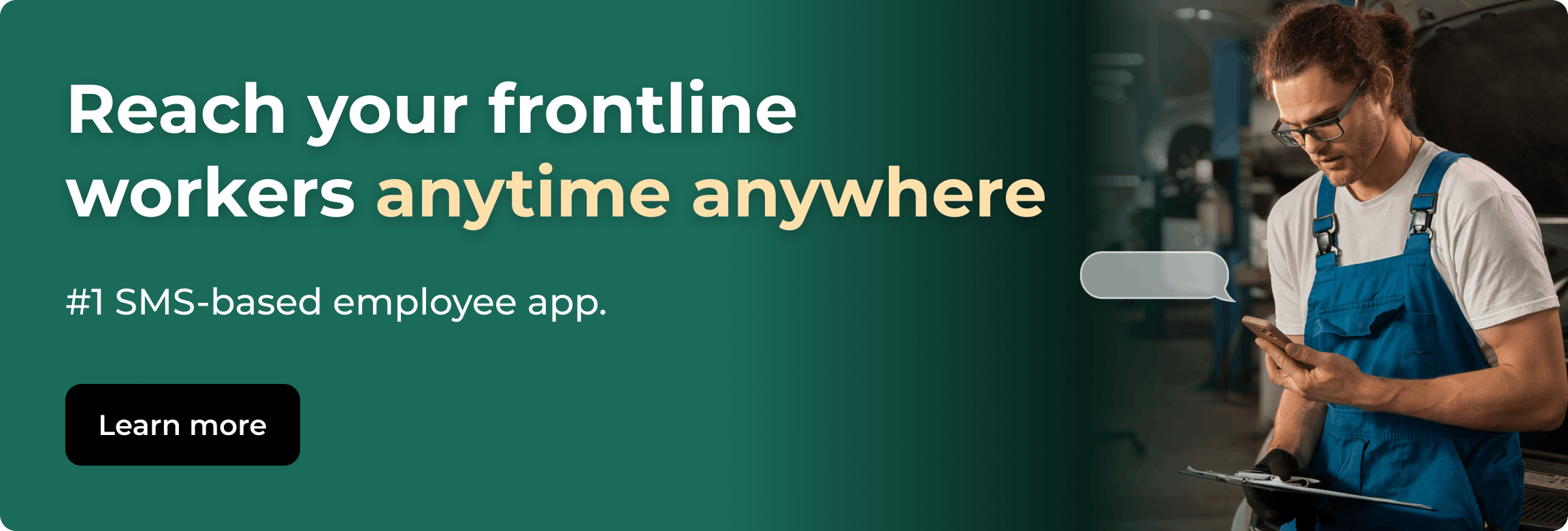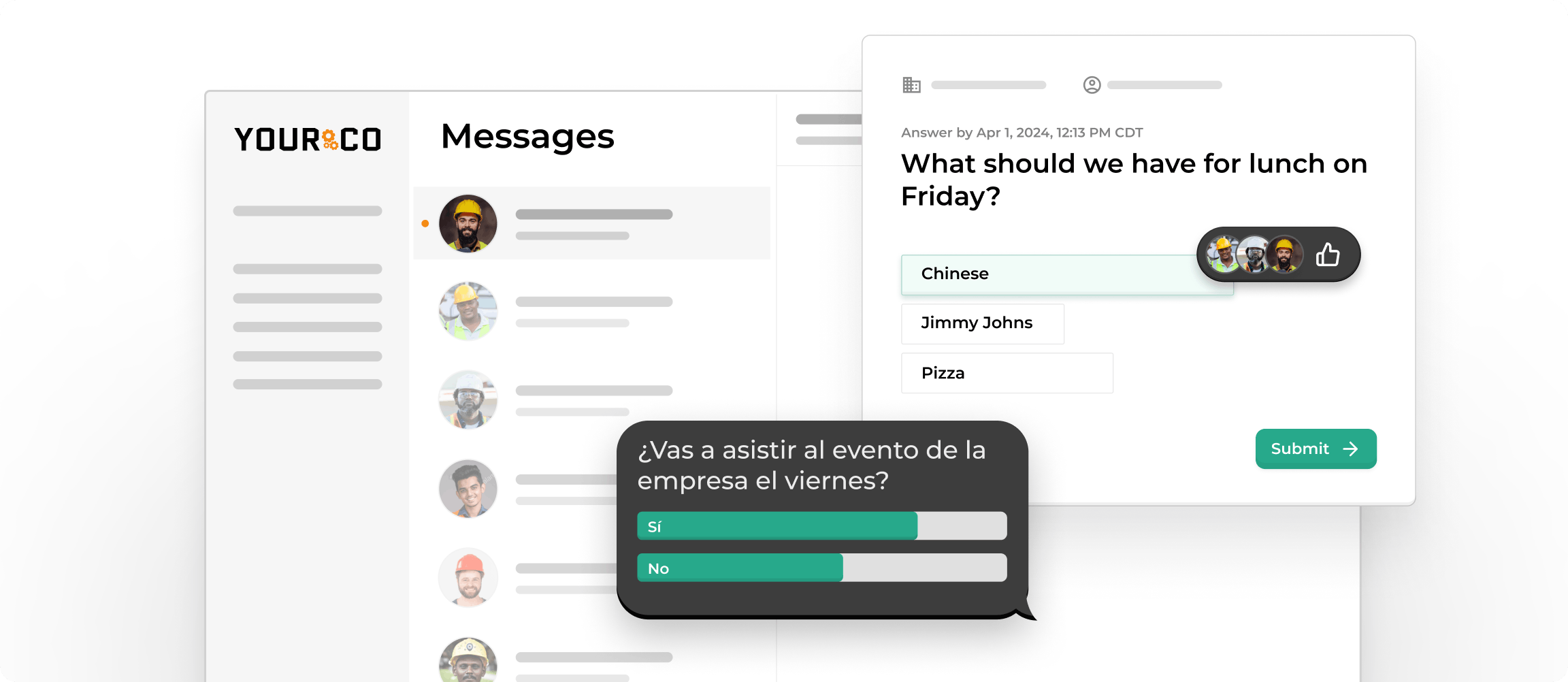7 Shift-Management Strategies for Hospitality Teams


Restaurant kitchens, hotel housekeeping, and front-desk operations never stop moving. When a server calls out during the dinner rush, a housekeeper misses their morning shift, or a bartender gets stuck in traffic during peak hours, your entire service can suffer. In hospitality and food service, staffing gaps don't just hurt productivity. They directly impact guest experience and revenue.
Smart hospitality leaders are turning to predictive scheduling, which uses historical occupancy rates, seasonal booking patterns, and local event calendars to staff the right number of people before rushes hit. This approach reduces labor costs while ensuring you have enough coverage during busy periods without violating predictive scheduling laws that require advance notice for shift changes.
But forecasts only work if everyone gets updates quickly. Most hospitality workers don't check email regularly, and asking them to download another app usually fails. Text messages cut through the noise, as they land on any phone, get read within seconds, and create a clear record for future disputes.
Here are seven practical strategies to build smoother, worker-friendly schedules that keep service flowing seamlessly.
1. Predictive, Data-Driven Scheduling
Predictive scheduling uses your historical data to plan future coverage, showing you exactly how many servers, cooks, and housekeepers you'll need before the week starts. The process works by analyzing years of occupancy patterns, reservation data, and seasonal trends to spot when you'll be slammed or slow.
Hotels can match housekeeping staff to checkout patterns and arrival waves, while restaurants can review sales data and local event schedules to predict heavy service nights. When you get this right, you stop paying for extra workers during slow Tuesday afternoons and avoid the chaos of being short-staffed when a convention books your restaurant for dinner.
Getting started is straightforward:
- Pick one department to test the system
- Gather six to twelve months of sales, occupancy, and staffing data
- Build a two-week schedule and compare your forecast to what actually happened
- Fine-tune the system, then expand to other areas
Real-time dashboards help managers catch problems early, while simple training keeps everyone comfortable with the changes. If local laws require advance notice, the system can handle compliance by flagging last-minute changes that trigger penalty wages.
Once your forecast-driven schedule is ready, getting it to your team takes seconds. Send text alerts to every employee, and they can reply "Y" to confirm their shift. No downloads needed —just quick confirmations that lock in coverage.
2. Flexible Shift Swapping & Self-Service Bidding
Moving from predictive planning to real-world flexibility means giving your crew the power to trade and claim shifts on their own. This reduces scheduling stress for everyone involved.
Open-shift marketplaces and peer-to-peer shift swaps transform static schedules into flexible plans that employees can adjust around real-life needs. When servers can pick up an extra Saturday night shift or housekeepers can hand off Sunday morning without tracking down a supervisor, you reduce last-minute call-offs and keep morale strong.
The key is making the process simple: one text with a unique link or a QR code in the break room lets someone claim an open slot in seconds. No logins or complicated processes — just a quick reply that updates the roster instantly.
- Automation maintains coverage while flexibility increases
- System checks skill requirements before approving swaps
- Hours-worked limits and fatigue rules prevent overworking
- Alerts notify you before gaps become problems
- Every change gets logged with employee identity, time, and date for audit trails
This automated oversight matters because unpredictable schedules tend to frustrate workers and drive turnover across hospitality operations.
3. Real-Time Text Communication & Alerts
Whether announcing shift swaps or urgent updates, text messaging reaches your hospitality crew instantly. SMS messages are read 98% of the time with replies arriving in roughly 90 seconds, while email open rates hover near 20% — a gap that makes all the difference when shifts are on the line. Because texts work on any phone and don't require data, every employee stays in the loop, even those without smartphones.
Consider the moments when minutes matter: a server calls out ten minutes before the dinner rush, a thunderstorm forces outdoor dining to close, or a last-minute banquet booking triggers mandatory overtime. With one outbound message, you can broadcast the update and (if you enable replies) let workers confirm, decline, or ask questions immediately. One-way alerts keep everyone informed, while two-way threads let you solve problems in real time.
Modern text platforms create comprehensive audit trails:
- Each message gets logged with a timestamp and delivery receipt
- When disputes surface ("I never got that overtime notice"), you have searchable proof
- Message archives help operations teams trace decisions after service incidents or wage claims
The speed advantage delivers real results. At a busy downtown restaurant, a manager can fill an uncovered shift in under five minutes by messaging the five servers qualified for that section. The first to reply "Yes" gets the assignment, and service stays on track.
4. Multilingual Messaging for Inclusive Coordination
Language gaps can turn into service gaps when updates need to land fast. Hotels, restaurants, and catering operations often run crews that speak multiple languages. An English-only text about a kitchen fire alarm can leave part of the team guessing instead of evacuating safely.
OSHA notes that safety notices must be "in a language and vocabulary workers can understand." If a grease fire alert only reaches the English speakers, you risk injuries, downtime, and fines. Beyond safety, misunderstandings around shift changes, overtime, or tip distribution create frustration and turnover.
AI-powered translation makes this simple:
- Tag each worker's preferred language in your system
- Messages auto-translate before hitting their phone
- No apps, no extra steps — just clear instructions in words they already know
- Platforms learn your company's terminology, keeping "86" or "comp" consistent across languages
Consider a Saturday evening at a busy hotel restaurant. A kitchen equipment failure pops up, and within seconds, the Spanish-speaking prep cooks receive: "Equipo de cocina descompuesto: usar estación de respaldo." The English version reaches the rest of the team simultaneously. Everyone understands, adjustments happen quickly, and you avoid service delays.
5. Skills-Based Scheduling & Cross-Training Pathways
A skills matrix lets you match every shift with the right talent so you're never scrambling when someone calls out. By logging each worker's certifications, experience, and proficiency level, you can see at a glance who can safely operate the fryer, work the front desk, or handle wine service.
Build your skills system:
- Document every skill in one shared sheet or scheduling tool
- Color-code proficiency levels so managers can spot gaps instantly
- Tag each employee's contact method for automated backup alerts
- Set up texts that ping certified backups the moment a shift opens
Cross-training tackles another major headache: high turnover. Lack of growth opportunities drives people away from hospitality jobs. Building a program that rotates employees through multiple roles keeps work interesting and spreads knowledge across your team.
Clear visibility into who can do what also makes smarter training investments possible. If Tuesday's report shows only one bartender available on nights, you know exactly where to focus the next training slot. Skills-based scheduling turns individual know-how into a company-wide safety net, boosting resilience during peak demand and giving employees a clear path to grow.
6. Continuous Feedback Loops & Engagement Analytics
When you end each shift with a quick, text-based pulse survey, everyday conversations become actionable data. Because text messages deliver such high engagement rates, you get near-real-time insights while details are still fresh in everyone's mind.
Simple survey examples:
- "Rate this week's tip distribution fairness on a 1-5 scale"
- "Did you have the equipment you needed today—yes or no?"
- "How likely are you to pick up an extra shift next week?"
These quick check-ins give you actionable feedback without overwhelming workers with lengthy questionnaires.
Patterns emerge within minutes. If a certain restaurant location reports low fairness scores for two weeks straight, you can drill into schedules and spot whether overtime keeps piling onto the same servers. This rapid feedback helps you adjust schedules before frustration turns into no-shows or resignations.
SMS surveys also create an audit trail. Each reply gets time-stamped and stored alongside shift records, giving you concrete proof that you checked in with employees and addressed concerns. When trends warrant deeper insight, AI sentiment analysis can flag trouble spots by location or department, guiding you toward targeted fixes like additional training or better break coverage.
The loop closes when you broadcast the outcome: "Thanks for your feedback—starting Monday, we're adding a food runner to cover rush hour." Employees see immediate action, which reinforces trust and boosts participation in the next survey.
7. AI-Powered Shift Optimization & Scenario Planning
AI removes the guesswork from shift planning by learning from your existing information. Every clock-in time, busy period, and absence creates patterns that help you predict staffing needs and test different scenarios before publishing schedules.
Real-world example: A regional hotel chain used this approach for holiday weekend planning. They fed two years of occupancy, restaurant sales, and staffing data into their system, then created three different schedules for high, moderate, and low occupancy scenarios. When bookings suddenly jumped, managers activated the "high occupancy" plan and filled extra housekeeping and front-desk shifts within minutes. This avoided the usual scramble and overtime costs that hurt profit margins.
Getting started:
- Export your last 12 months of shift data, labor costs, and absence records
- Import this into any forecasting tool that handles scheduling data
- Basic analysis will show patterns you can use right away
- Advanced platforms automatically improve predictions as new information comes in
AI handles multiple factors at once: labor budgets, worker availability, skills, and compliance rules, so you don't have to choose between following regulations and having enough coverage. This means right-sized teams during slow periods and full staffing when guests need attention.
Keep Your Hospitality Team Running Smoothly
When you combine smart scheduling, easy shift swaps, instant text alerts, multilingual support, compliance tracking, skills visibility, regular feedback, and AI planning, managing hospitality shifts becomes much simpler. Each strategy works with the others: better schedules prevent overstaffing, flexible swaps keep shifts covered, quick texts fill information gaps, and language support helps everyone stay informed.
Managing hospitality teams requires systems that give you control, clear information, and speed. Paper schedules and email chains can't handle today's reality where most workers don't sit at desks. Missed messages create service problems, wage disputes, and compliance headaches you can't afford.
Yourco handles this challenge directly. Our SMS platform sends instant alerts, translates messages into 135+ languages and dialects automatically, and keeps a complete record of every shift confirmation and response. No apps to download, no special equipment needed, just clear communication that reaches every worker on their phone.
Try Yourco for free today or schedule a demo and see the difference the right workplace communication solution can make in your hospitality operation.
Frequently Asked Questions
How fast can I launch Yourco?
With Yourco’s user-friendly interface, your teams can start sending SMS alerts within a day. Just upload contacts, complete initial account setup, and assign permissions, and you're set.
What if my workforce speaks multiple languages?
Tag each employee's preferred language once. Yourco auto-translates every outgoing text, so everyone gets the same clear instructions.
Can I use Yourco for last-minute shift changes or emergencies?
Yes. Yourco lets you send urgent updates instantly via SMS, so last-minute changes, like a call-out or weather delay, reach your team in seconds. You can even request confirmation replies to lock in replacements fast.
Does Yourco integrate with our existing scheduling or HR systems?
Yes. Yourco connects with over 240 HRIS and payroll platforms. This means your employee data stays synced, and shift alerts, confirmations, and responses can be tracked alongside your existing tools.




